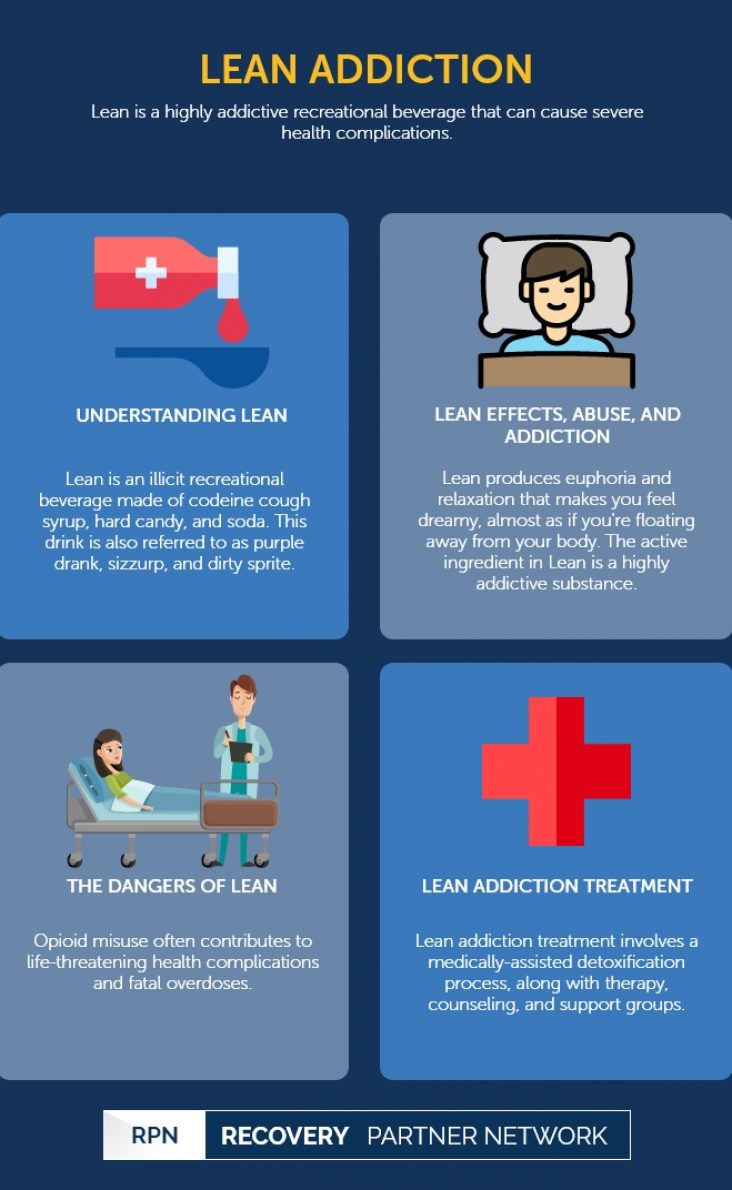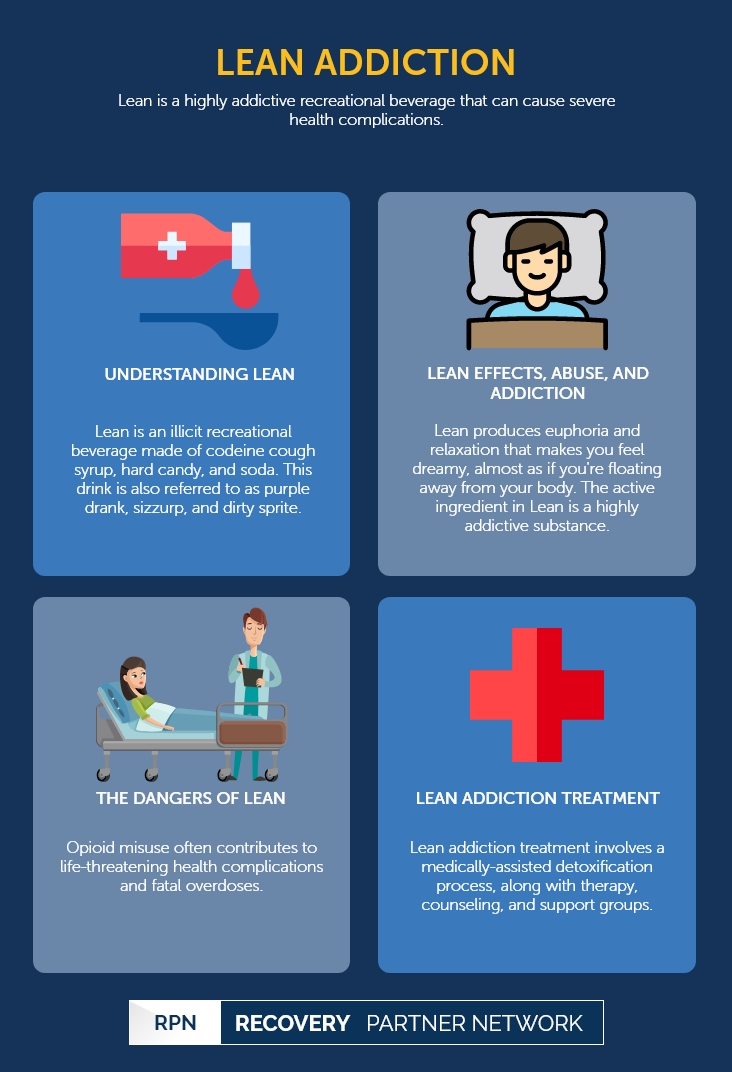Lean is a highly addictive recreational beverage that can cause severe health complications.
Lean Addiction
Opioid
- Hydrocodone/paracetamol addiction
- Buprenorphine/Naloxone addiction
- Central nervous system depressant
- Codeine addiction
- Dextropropoxyphene addiction
- Fentanyl abuse
- Hydromorphone addiction
- How Long do Opioids Stay in Your System?
- Hydrocodone addiction
- Kava addiction and abuse
- Loperamide addiction
- Lortab addiction
- Medical prescription opioid
- Methadone addiction
- Morphine addiction
- Norco addiction
- NyQuil addiction
- Opioid use disorder
- OTC substance abuse
- Oxycodone addiction
- Oxycodone/paracetamol addiction
- Opioid epidemic
- Lean addiction
- Pethidine addiction
- Snorting Oxycodone
- Synthetic Opioids
- Tramadol addiction
Lean addiction | Table of Contents
Understanding Lean
Lean is an illicit recreational drink made of codeine cough syrup, hard candy, and soda. Similar to morphine, codeine is derived from the opium poppy plant, but it is considered one of the weaker forms of opioids. Nevertheless, its highly addictive feature makes it an illicit substance that can cause severe health complications when abused.
Other names of lean may include:
- Purple drank
- Sizzurp
- Dirty sprite
Lean was initially popular among the blue musicians in Houston who blended Robitussin ® with beer. Later, in the 1980s, Houston rappers reinvented it using codeine, soda, and a piece of hard candy (usually Jolly Ranchers) for sweetness. The popularity of the drink expanded across the south, becoming the focus of numerous songs, like Three 6 Mafia (“Sippin on Some Sizzurp”), Future (“Dirty Sprite”), and Lil Wayne (“Me and My Drank”). This beverage is now popular among the young worldwide due to its influence on pop culture and has contributed to many fatal consequences.
FAQ
Codeine, the main ingredient in lean, had been misused by people for a long time, but it rose to fame with the prominence it was given in pop culture.
The primary signs of addiction may include the symptoms of cravings, withdrawal, and tolerance to lean consumption. Individuals who consume lean as a form of self-medication may also form an addiction.
Lean Effects, Abuse, and Addiction
The term “lean” derives from the position that it tends to put the user in after consuming the beverage as they lean or slouch to one side the more they drink. The effects of codeine are similar to those of other addictive opioids like oxycodone and heroin. Usually, the effects kick in within 30 to 45 minutes, while various doses of codeine in lean (up to 25 times the prescribed dose) can shorten onset times. The peak of the effects occurs 1 to 2 hours after intake and continues about 4 to 6 hours.
Lean produces euphoria and relaxation that makes you feel dreamy, almost as if you’re floating away from your body. Since its active ingredient is a central nervous system (CNS) depressant lean acts on the central nervous system and slows down brain function for a sedating effect.
Although some people may experience the euphoric effects of lean, it may also produce effects that are unpleasant and even very dangerous at higher doses, including:
- Loss of co-ordination
- High body temperature
- Nausea and vomiting
- Itchy skin
- Hallucinations
- Extreme sedation
- Severe constipation
- Dizziness
- Seizures
- Loss of consciousness
- Changes in heart rhythms
- Respiratory depression
Lean addiction can progress within a short period due to the way opioids short-circuit the brain’s reward system. The active ingredient found in lean increases the level of dopamine in the brain’s reward system and thus contribute to its addiction.
Unlike dependency, which involves the body merely getting used to a substance, addiction induces cravings and a total lack of control over substance use.
Signs of lean addiction include the following:
- Requiring higher doses of lean overtime
- Unable to quit lean consumption even when it causes issues at work, home, or school
- Experiencing cravings
- Depending on lean-to alleviate stress and depression
- Experiencing withdrawal symptoms
Lean withdrawal symptoms may include:
- Stomach cramps
- Diarrhea
- Loss of appetite
- Nausea and vomiting
- Insomnia
- Enlarged pupils
- Shakiness
- Body pain
- Fever and chills
The Dangers of Lean
Many lean users overlook the risks of consuming codeine, and opioid misuse often causes the body to develop a tolerance to its effects. During the gradual development of tolerance, the body produces less and less of its own natural opioids until it is fully reliant on the foreign substance. During this stage of dependence and tolerance, users will require higher and higher doses to experience the desired effects while also requiring the substance to function on a daily basis.
Opioid misuse may often contribute to life-threatening health complications and sometimes fatal overdoses. Upon drinking too much lean, the brain is overloaded with opioid molecules and cannot control its reaction or mitigate its effect. Subsequently, the decreased respiratory rate triggered by consuming lean can become a complete cessation of the individual’s ability to breathe. Once breathing fails, the brain can no longer obtain enough oxygen to function properly. The lack of oxygen in the brain can lead to a coma or even a fatal overdose.
FAQ
- What makes lean so dangerous?
- What happens if you add alcohol to lean?
- What Is the effect of lean on your nervous system?
Lean is a dangerous substance due to its active ingredient, codeine. The effects of consuming large quantities of codeine are similar to heroin or morphine use. It also has a high potential for addiction and abuse. The high concentrations of codeine in lean can lead to brain and other system damages. Lean also contains Promethazine, which is a central nervous system depressant that can lead to slow breathing and even complete respiratory arrest when cojoined with codeine. Lean has significant amounts of DXM (Dextromethorphan), which is a cough suppressant that has the capacity to form an addiction.
Combining alcohol with lean can intensify the effects of each substance leading to an increased risk of overdose and long-term health complications.
Lean can produce a sedating effect by acting on the central nervous system (CNS) and slowing down brain activity.
"Robotripping" with DXM Cough Syrup
In some parts of America, lean drinkers have substituted codeine with another over-the-counter (OTC) prescription cough medication named dextromethorphan (DXM). DXM can be found in cough syrups, such as NyQuil ®, Theraflu ®, and Robitussin ®. The consumption of the DXM-soda-candy mix is known as “robotripping.” DXM is different from opioids and codeine since DXM works on the same receptors as hallucinogens, such as ketamine or PCP. DXM belongs to a class of dissociative drugs that induce out-of-body hallucinations.
Possible side effects of Robotripping include:
- Increased blood pressure
- Loss of co-ordination
- Numbness
- Nausea
- Dizziness
- Rapid heart rate
- Seizures
- Reduced oxygen to the brain (in rare cases)
- Hallucinations
- Memory loss
Lean Addiction Statistics
- 200 Percent: Codeine-related deaths doubled between 2000 and 2009 in Australia.
- 3.6 Percent: 3.6 percent of 10th graders reportedly abused cough syrups in 2017.
- 148 Gallons: Texas estimated that about 148 gallons of hydrocodone cough syrups were used for illegal consumption in 1998.
Lean Addiction Treatment
It could be difficult for a person suffering from lean addiction to limit or quit use. Lean addiction may require treatment, counseling, and occasionally some medications to manage withdrawal symptoms. The initial stage of addiction treatment involves the detoxification process. Opioid treatment medicines can be used to alleviate painful withdrawal symptoms. Detox can also identify comorbid diseases or conditions (such as hepatitis or nerve damage). Accordingly, a medically-assisted detox is an important aspect of ensuring a safe and successful recovery from lean addiction.
Recovery Partner Network
We aim to educate and empower. If you feel our library of resources does not cover your specific need, reach out to us, and we would be happy to help.
STATISTICS
© Copyright 2025


